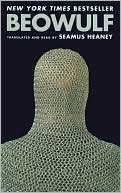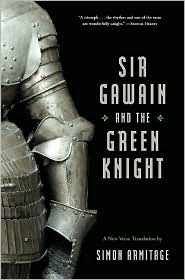N.B.: THIS POST WILL NOT ACTUALLY COMPLETE YOUR HOMEWORK/BOOK REPORT FOR YOU. NOR WILL THE PERSON WHO POSTED IT.
 The specific version of Beowulf I'm talking about today is the translation from the Old English done by noted poet, Seamus Heaney. The book comes in two versions: the one pictured there to the left, and an illustrated edition with a photograph of a dagger on the front cover. The version to the left contains the Old English on the left-hand pages and the modern English translation on the right. It's the recommended version of the text for most schools because, I assume, there are still some teachers out there who like to torture kids with the Old English, at least a bit, as my teacher did when I was in high school an aeon ago. I should add that I think it's cool to understand that our modern language evolved from something else, and to note the similarity to, say, German or Norse languages. But as most teens don't learn German or Norse languages, and most teachers can't read Old English, really, I think this is something that might better be left to, say, college linguistics classes.
The specific version of Beowulf I'm talking about today is the translation from the Old English done by noted poet, Seamus Heaney. The book comes in two versions: the one pictured there to the left, and an illustrated edition with a photograph of a dagger on the front cover. The version to the left contains the Old English on the left-hand pages and the modern English translation on the right. It's the recommended version of the text for most schools because, I assume, there are still some teachers out there who like to torture kids with the Old English, at least a bit, as my teacher did when I was in high school an aeon ago. I should add that I think it's cool to understand that our modern language evolved from something else, and to note the similarity to, say, German or Norse languages. But as most teens don't learn German or Norse languages, and most teachers can't read Old English, really, I think this is something that might better be left to, say, college linguistics classes.Does that mean we shouldn't all read Beowulf? Not at all. Beowulf is an extremely old story that is still interesting and relevant, and a way of looking at the ancient history of the Anglo-Saxons. But better than that, Beowulf the character is, in essence, the prototype of what we now call a "superhero." Not only was he a hero, in the same way that Hercules or Achilles had been, but he was almost superhuman in his strength and courage. Despite having been mocked in his homeland, he remained calm and kind, proving others wrong through his actions, not through his words. Interestingly, in this long (and sometimes convoluted) epic poem, which is a demonstration of effective use of words, the take-home message is that it is deeds, not words, that really matter.
More about Beowulf:
One of the things that is helpful about the Heaney text is the use of small notes in the far right margin that give readers signposts. Those notes kind of sum up what's going on and keep you grounded with where you are in the story. Reading the notes won't actually tell you the whole story (not by a long shot), and they completely bypass the really cool stuff, like the deadly wrestling match between Beowulf and Grendel, or the wrestling match turned knife fight with Grendel's mother, or the final showdown with the dragon.
One of the things that Heaney does in his translation is that he uses some of the principals of Anglo-Saxon poetry. Anglo-Saxons used poetic lines that basically split in half in the middle, and each half of the line contains two stressed syllables. Anglo-Saxons also used a lot of alliteration, or repetition of sounds (and, in particular, of the sounds starting words in the line. Here's an example of what I'm talking about, from lines 442-445:
If Grendel wins, it will be a gruesome day;
he will glut himself on the Geats in the war-hall,
swoop without fear on that flower of manhood
Stressed syllables are underlined; alliteration within a line is bolded.
 Sir Gawain and the Green Knight, translated by Simon Armitage, is a great deal of fun, and an altogether faster read than Beowulf (as in, I read Beowulf in pieces over a matter of days, and I was able to read Sir Gawain in a single sitting in a matter of hours.
Sir Gawain and the Green Knight, translated by Simon Armitage, is a great deal of fun, and an altogether faster read than Beowulf (as in, I read Beowulf in pieces over a matter of days, and I was able to read Sir Gawain in a single sitting in a matter of hours. Sir Gawain and the Green Knight was originally written in Middle English sometime in the 14th century, most likely by someone from Northern England (according to the introduction). But it shares some of the hallmarks of Anglo Saxon poetry that we discussed before: lines which have at least an internal break with two stressed syllables per half-line and plenty of alliteration. In addition, this poem features occasional inset lines (really, half lines split apart), in order to emphasize the fact that the inset lines contain rhyme. As in Beowulf, the left-hand pages contain the Middle English, and the right-hand pages contain the translation. Here are lines 580-589:
Then comes the suit of shimmering steel rings
encasing his body and his costly clothes:
well burnished braces to both of his arms,
good elbow guards and glinting metal glove,
all the trimmings and trappings of a knight tricked out
to ride:
a metal suit that shone;
gold spurs which gleam with pride;
a keen sword swinging from
the silk belt to his side.
Another similarity to Beowulf, which may not be accidental, is the struggle between a good knight and an otherworldly being, the Green Knight, whose head Gawain chops off with an axe on first meeting, but who picks up his head and tells Gawain to meet him for a final challenge in a year's time. The story is full of Medieval imagery and folklore images that include Germanic and Celtic traditions (including references to the Green Man and more). Armitage's translation is easy to get through. As Heaney did for Beowulf, he tries to maintain the rhythms of the original, but he doesn't always translate 100% faithfully, in part because he felt that preserving the poem as a poem was more important than getting it all the way right.
Those of you reading Beowulf can be envious that you didn't get the slightly easier text to read. Those of you reading Sir Gawain can envy the Beowulf crowd their access to good graphic novel versions to help them along. Poetry fans will enjoy the rocking rhythm of Anglo Saxon poetry, and may be inspired to write some verse using its devices. I know I'm going to give it a whirl.

Over at The Graphic Classroom, we've reviewed several of the Beowulf graphic novels, and both Chris (the editor) and I think just so highly of Gareth Hinds. I just reviewed his graphic adaptation of The Merchant of Venice, which just reinforces my admiration of him as an adaptor of classics.
ReplyDeleteIn addition to both the Petrucha and Hinds versions, there is Beowulf: Monster Slayer by Paul D. Storrie which is definitely worth mentioning, geared for a slightly younger crowd.
Schoey.
Thanks, Schoey! I loved Hinds's illustrations, too - he's talented. But I liked the battle descriptions within the poem best, so I kinda missed the text (although he brought them "to life" well!)
ReplyDeleteMy library didn't have the other Beowulf, which also got a CYBILS nomination in 2007. I'll have to keep an eye out for it.